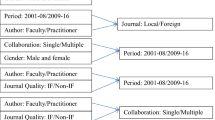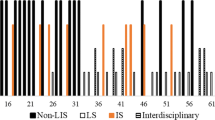Abstract
This paper presents a quantitative study of productivity, characteristics and various aspects of global publication in the field of library and information science (LIS). A total of 894 contributions published in 56 LIS journals indexed in SSCI during the years of 2000-2004 were analyzed. A total of 1361 authors had contributed publications during the five years. The overwhelming majority (89.93%) of them wrote one paper. The average number of authors per paper is 1.52. All the studied papers were published in English. The sum of research output of the authors form USA and UK reaches 70% of the total productivity. Most papers received few citations. Each article received on an average 1.6 citations and the LIS researchers cite mostly latest articles. About 48% of citing authors had tendency of self-citation. The productive authors, their contribution and authorship position are listed to indicate their productivity and degree of involvement in their research publications.
Similar content being viewed by others
References
Black, P. E. (2004), Lotka’s Law in Dictionary of Algoritms and Data Structures [online], US. National Institute of Standards and Technology. 17 Decmber 2004. (Accessed: 18 OCT 2006) available from: http://www.nist.gov/dads/HTML/LotkasLaw.html
Gami, A. S. & AL. (2004), Author self-citation in the diabetes literature. CMAJ, 170 (13): 1925–1927.
Garfield, E. (1998), Random thoughts on citationology: its theory and practice. Scientometrics, 43: 69–76.
Garfield, E. (1979), Citation Indexing: Its Theory and Application in Science, Technology and Humanities. New York: Wiley.
Ginn, L. K. (2003), Citation analysis of authored articles in library & information science research, 2001–2002. Mississipi Libraries, 67: 106–109.
Glänzel, W. & AL. (2006), A concise review on the role of author self-citations in information science, bibliometrics and science policy. Scientometrics, 67: 263–277.
Gu, Y. (2004), Global knowledge management research: A bibliometric analysis. Scientometrics, 61: 171–190.
Gupta, B. M, KUMAR, S. (2001), Citation analysis of theoretical population genetics literature. Library Herald, 39 (4): 208–226.
Hara, N. & AL. (2003), An emerging view of scientific collaboration: scientists perspectives on collaboration and factors that impact collaboration. Journal of the American Society for Information Science and Technology, 54 (10): 952–965.
Khan, M. S. & AL. (1998), Library and information science literature in Bangladesh: A bibliometric study. Malaysian Journal of Library and Information Science, 3 (2): 11–34.
Koufogiannakis, D. & AL. (2004), A content analysis of librarianship research. Journal of Information Science, 30 (3): 227–239.
Kumpulainen, S. (1999), Library and information science research in 1975: Content analysis of the journal articles. LIBRI, 41 (1): 59–76.
Lipetz, B. (1999), Aspects of JASIS authorship through four decades. Journal of the American Society for Information Science, 50: 994–1003.
Mcveigh, M. E. (2004), Open Access Journals in the ISI Citation Databases: Analysis of Impact Factors and Citation patterns. Thomson Corporation. Available at: http://www.isinet.com/oaj (accessed: 6 Nov 2006)
Nour, M. M. (1985), A quantitative analysis of the research articles published in core library journals of 1980. Library and Information Science Research, 7: 261–273.
Peritz, B. C. (1980), The methods of library science research: some results from a bibliometric survey. Library Research, 2 (3): 251–268.
Rochester, M. K., Vakkari, P. (2003), International library and information science research: A comparison of national trends. In: IFLA Professional Reports, Nr. 82.
Russel, J. M. (2001), Scientific communication at the beginning of the twenty-first century. ISSJ, 168: 271–282.
Schloegl, C., Stock, W. G. (2004), Impact and relevance of LIS journals: A scientometric analysis of international and German language LIS journals-citation analysis versus readers survey. Journal of the American Society for Information Science and Technology, 55 (13): 1155–1168.
Seglen, P. O. (1997), Why the Impact Factor of journals should not be used for evaluation research. BMJ, Feb 1997:314:497. Available at: http://www.bmj.com (accessed:9 DEC 2006)
Sen, B. K., Taib C. A. B., Hassan, M. F. B. (1996), Library and information science literature and Lotkas law. Malaysian Journal of Library & Information Science, 1 (2): 89–93.
Author information
Authors and Affiliations
Corresponding author
Rights and permissions
About this article
Cite this article
Davarpanah, M.R., Aslekia, S. A scientometric analysis of international LIS journals: Productivity and characteristics. Scientometrics 77, 21–39 (2008). https://doi.org/10.1007/s11192-007-1803-z
Received:
Published:
Issue Date:
DOI: https://doi.org/10.1007/s11192-007-1803-z




